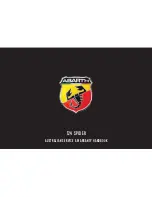
pressure will also increase as the vehicle is driven - this
is normal and there should be no adjustment for this
increased pressure.
•
The TPM System will warn the driver of a low tire
pressure if the tire pressure falls below the low-
pressure warning limit for any reason, including low
temperature effects and natural pressure loss through
the tire.
•
The TPM System will continue to warn the driver of
low tire pressure as long as the condition exists, and
will not turn off until the tire pressure is at or above
the recommended cold placard pressure. Once the low
tire pressure warning (Tire Pressure Monitoring Tell-
tale Light) illuminates, you must increase the tire
pressure to the recommended cold placard pressure in
order for the Tire Pressure Monitoring Telltale Light to
turn off. The system will automatically update and the
Tire Pressure Monitoring Telltale Light will turn off
once the system receives the updated tire pressures.
The vehicle may need to be driven for up to 10 minutes
above 15 mph (25 km/h) in order for the TPMS to
receive this information.
− For example, your vehicle may have a recom-
mended cold (parked for more than three hours)
placard pressure of 30 psi (207 kPa). If the ambient
temperature is 68 F (20 C) and the measured tire
pressure is 27 psi (186 kPa), a temperature drop to 20
F (-7 C) will decrease the tire pressure to approxi-
mately 23 psi (157 kPa). This tire pressure is suffi-
ciently low enough to turn ON the Tire Pressure
Monitoring Telltale Light. Driving the vehicle may
cause the tire pressure to rise to approximately 27
psi (186 kPa), but the Tire Pressure Monitoring
Telltale Light will still be ON. In this situation, the
Tire Pressure Monitoring Telltale Light will turn
OFF only after the tires are inflated to the vehicle’s
recommended cold placard pressure value.
STARTING AND OPERATING
311
5
Summary of Contents for 2008 Avenger
Page 1: ...Avenger O W N E R S M A N U A L 2 0 0 8 ...
Page 4: ......
Page 7: ...INTRODUCTION 5 1 ...
Page 10: ......
Page 112: ...110 UNDERSTANDING THE FEATURES OF YOUR VEHICLE ...
Page 113: ...UNDERSTANDING THE FEATURES OF YOUR VEHICLE 111 3 ...
Page 114: ...112 UNDERSTANDING THE FEATURES OF YOUR VEHICLE ...
Page 169: ...INSTRUMENT PANEL FEATURES Instrument Panel Features UNDERSTANDING YOUR INSTRUMENT PANEL 167 4 ...
Page 170: ...INSTRUMENT CLUSTER BASE 168 UNDERSTANDING YOUR INSTRUMENT PANEL ...
Page 171: ...INSTRUMENT CLUSTER PREMIUM UNDERSTANDING YOUR INSTRUMENT PANEL 169 4 ...
Page 251: ...UNDERSTANDING YOUR INSTRUMENT PANEL 249 4 ...
Page 300: ...298 STARTING AND OPERATING ...
Page 348: ......
Page 357: ...Jacking Locations WHAT TO DO IN EMERGENCIES 355 6 ...
Page 370: ...2 4L ENGINE COMPARTMENT 368 MAINTAINING YOUR VEHICLE ...
Page 371: ...2 7L ENGINE COMPARTMENT MAINTAINING YOUR VEHICLE 369 7 ...
Page 372: ...3 5L ENGINE COMPARTMENT 3 5L Engine 370 MAINTAINING YOUR VEHICLE ...
Page 434: ......
Page 445: ...INDEX 10 ...
















































